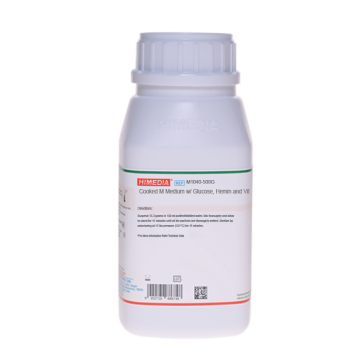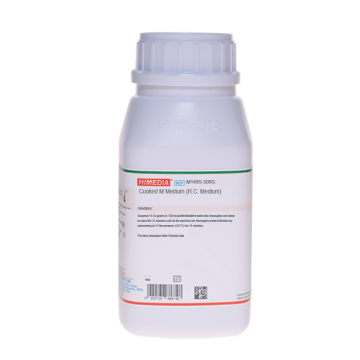 Your enquiry has been submitted
Your enquiry has been submitted
Cooked Meat Medium (Revised as Cooked M Medium) (R.C.Medium)
Intended use
Recommended for cultivation of aerobes and anaerobes, especially pathogenic Clostridia from clinical, food and water samples. This can also be used as a maintenance medium for stock cultures.
Composition**
| Ingredients | g / L |
|---|---|
| HMH peptone B # | 98.000 |
| Proteose peptone | 20.000 |
| Dextrose(Glucose) | 2.000 |
| Sodium chloride | 5.000 |
Final pH ( at 25°C): 7.2±0.2
**Formula adjusted, standardized to suit performance parameters
# Equivalent to Beef heart, solids
Directions
Suspend 12.5 grams in 100 ml purified/distilled water (or suspend 1.25 grams in 10 ml distilled water in test tubes). Mix thoroughly and allow to stand for 15 minutes until all the particles are thoroughly wetted. Dispense into tubes or flasks as desired. Sterilize by autoclaving at 15 lbs pressure (121°C) for 15 minutes.
Principle And Interpretation
Clostridium is a large genus of gram-positive spore-bearing anaerobes. They are normally present in soil, some are responsible for human and animal diseases and others are associated with food spoilage. They may be saccharolytic, decomposing sugars to form butyric and acetic acids and alcohols. The HMH peptone in Robertson's Medium is reddened and gas is produced. Other proteolytic species attack the amino acids. HMH peptone B in Robertson's medium is blackened and decomposed by Clostridium species, giving the culture a foul odour. The mesophilic spore-forming anaerobes are of primary importance in the spoilage of low acid foods packed in sealed containers, because of their high heat resistance, their ability to grow in the absence of oxygen and a growth range which covers the temperature of normal storage of canned and other processed foods including the refrigerated storage of cured meats.
Cooked M-Medium was originally developed by Robertson (1) for the cultivation of certain anaerobes isolated from wounds. The present formulation is a modification, also called as Chopped M-Medium (2), which supports the growth of many spore forming and non-spore forming strict anaerobes. It has the ability to initiate growth of bacteria from very small inocula and to maintain the viability of cultures over long period. Mixed cultures of bacteria survive in Cooked M-Medium without displacing the slower-growing organisms. The products of growth do not rapidly destroy the inoculated organisms and therefore it is an excellent medium for the storage of aerobic and anaerobic organisms. It is used for cultivation and maintenance of Clostridia and for determining proteolytic activity of anaerobes (2,3). FDA has recommended this medium for enumeration and identification of Clostridium perfringens from foods (4).
Cooked M-Medium contains HMH peptone B, which provide amino acids and other nutrients. It also contains glutathione, a reducing substance that permits the growth of obligate anaerobes. The sulfhydryl groups, which impart reducing effect, are more available in denatured protein and hence cooked meat is added in the medium. The addition of dextrose allows rapid and heavy growth of anaerobic bacteria in a short time and leads to more rapid identification of important anaerobes. Growth in this medium is indicated by turbidity or bubble formation by some organisms. Blackening and disintegration of the meat particles indicate proteolysis. For best results, medium should be used on the day it is prepared, otherwise it should be boiled or steamed for a few minutes and allowed to cool without agitation and then inoculated. Inoculation should be made near the bottom of the tube in the meat particles for anaerobic cultures. Aerobes grow at the top whilst more anaerobic species grow deeper in the medium. For the isolation of Clostridium from food, use a stomacher to prepare 10% suspension of the food in Peptone Water (M028) diluent.
Make dilutions and plate, both suspensions and dilutions on Willis and Hobbs Medium Base (M1375), Tryptose Sulphite Cycloserine (T.C.S.) Agar Base (M837). Place a metronidazole disc on the inoculum. Incubate anaerobically at 37°C overnight. To count the clostridia, pour the plates with the dilutions on Perfringens Agar Base (O.P.S.P.) (M579). Incubate duplicate plates aerobically and anaerobically to distinguish between clostridia and other organisms. Add some of the suspension to two tubes of Cooked Medium. Heat one tube for 10 min at 80°C and incubate as above. Growth of clostridia is visualized as turbidity or gas bubbles. This medium can be further tested for presence of Clostridium (5).
Type of specimen
Clinical samples - Faeces, wounds, tissue, pus etc. ; Food and dairy samples; Water samples
Specimen Collection and Handling
For clinical samples follow appropriate techniques for handling specimens as per established guidelines (5,6).
For food and dairy samples, follow appropriate techniques for sample collection and processing as per guidelines (7,8).
For water samples, follow appropriate techniques for sample collection, processing as per guidelines and local standards (9).
After use, contaminated materials must be sterilized by autoclaving before discarding.
Warning and Precautions
In Vitro diagnostic Use. For professional use only. Read the label before opening the container. Wear protective gloves/protective clothing/eye protection/ face protection. Follow good microbiological lab practices while handling specimens and culture. Standard precautions as per established guidelines should be followed while handling clinical specimens. Safety guidelines may be referred in individual safety data sheets
Limitations
- Further biochemical tests must be carried out for confirmation.
Performance and Evaluation
Performance of the medium is expected when used as per the direction on the label within the expiry period when stored at recommended temperature.
Quality Control
Appearance: Brown coloured granules
Colour and Clarity of prepared medium: Medium amber coloured, clear to slightly opalescent supernatant over insoluble granules.
Reaction: Reaction of 12.5% w/v aqueous suspension at 25°C. pH : 7.2±0.2
pH: 7.00-7.40
Cultural Response: Cultural characteristics observed after an incubation at 35-37°C for 40-48 hours.
| Organism | Inoculum (CFU) | Growth |
|---|---|---|
| Clostridium botulinum ATCC 25763 | 50-100 | luxuriant |
| Clostridium perfringens ATCC 12924 | 50-100 | luxuriant |
| Clostridium sporogenes ATCC 11437 | 50-100 | luxuriant |
| Enterococcus faecalis ATCC 29212 (00087*) | 50-100 | luxuriant |
| Streptococcus pneumoniae ATCC 6303 | 50-100 | luxuriant |
Key :(*) - Corresponding WDCM numbers
Storage and Shelf Life
Store between 10-30°C in a tightly closed container and the prepared medium at 2-8°C. Use before expiry date on the label. On opening, product should be properly stored dry, after tightly capping the bottle inorder to prevent lump formation due to the hygroscopic nature of the product. Improper storage of the product may lead to lump formation. Store in dry ventilated area protected from extremes of temperature and sources of ignition Seal the container tightly after use. Product performance is best if used within stated expiry period.
Disposal
User must ensure safe disposal by autoclaving and/or incineration of used or unusable preparations of this product. Follow established laboratory procedures in disposing of infectious materials and material that comes into contact with clinical sample must be decontaminated and disposed of in accordance with current laboratory techniques (5,6).
Reference
- Robertson, 1916, J. Pathol. Bacteriol., 20:327.
- Murray P. R., Baron J. H., Pfaller M. A., Jorgensen J. H. and Yolken R. H., (Ed.), 2003, Manual of Clinical Microbiology, 8th Ed., American Society for Microbiology, Washington, D.C.
- MacFaddin J. F., 1985, Media for Isolation - Cultivation - Identification - Maintenance of Medical bacteria, Vol. I, Williams & Wilkins, Baltimore.
- U.S. Food and Drug Administration, 1984, Bacteriological Analytical Manual, 6th Ed., AOAC, Arlington, Va. Collins C. H., Lyne P. M., Grange J. M., 1985, 7th Ed., Microbiological Methods.
- Isenberg, H.D. Clinical Microbiology Procedures Handbook. 2nd Edition.
- Jorgensen,J.H., Pfaller , M.A., Carroll, K.C., Funke, G., Landry, M.L., Richter, S.S and Warnock., D.W.(2015)Manual of Clinical Microbiology, 11th Edition. Vol. 1.
- American Public Health Association, Standard Methods for the Examination of Dairy Products, 1978, 14thEd., Washington D.C.
- Salfinger Y., and Tortorello M.L. Fifth (Ed.), 2015, Compendium of Methods for the Microbiological Examination of Foods, 5th Ed., American Public Health Association, Washington, D.C.
- Lipps WC, Braun-Howland EB, Baxter TE,eds. Standard methods for the Examination of Water and Wastewater, 24th ed. Washington DC:APHA Press; 2023.
| Product Name | Cooked Meat Medium (Revised as Cooked M Medium) (R.C.Medium) |
|---|---|
| SKU | M149 |
| Product Type | Regular |
| Physical Form | Powder |
| Origin | Animal |
| Packaging type | HDPE |
| References | 1. American Public Health Association, Standard Methods for the Examination of Dairy Products, 1978, 14th Ed., WashingtonD.C. 2.Baird R.B., Eaton A.D., and Rice E.W., (Eds.), 2015, Standard Methods for the Examination of Water andWastewater, 23rd ed., APHA, Washington, D.C. 3.Collins C. H., Lyne P. M., Grange J. M., 1985, 7th Ed., Microbiological Methods. 4.Isenberg, H.D. Clinical Microbiology Procedures Handbook. 2nd Edition. 5.Jorgensen,J.H., Pfaller , M.A., Carroll, K.C., Funke, G., Landry, M.L., Richter, S.S and Warnock., D.W. (2015) Manual of Clinical Microbiology, 11th Edition. Vol. 1. 6.MacFaddin J. F., 1985, Media for Isolation - Cultivation - Identification - Maintenance of Medical bacteria, Vol. I, Williams & Wilkins, Baltimore. 7.Murray P. R., Baron J. H., Pfaller M. A., Jorgensen J. H. and Yolken R. H., (Ed.), 2003, Manual of Clinical Microbiology, 8th Ed., American Society for Microbiology, Washington, D.C. 8.Robertson, 1916, J. Pathol. Bacteriol., 20:32 9.Salfinger Y., and Tortorello M.L. Fifth (Ed.), 2015, Compendium of Methods for the Microbiological Examination of Foods, 5th Ed., American Public Health Association, Washington, D.C. |
| Customized Product Available | No |







